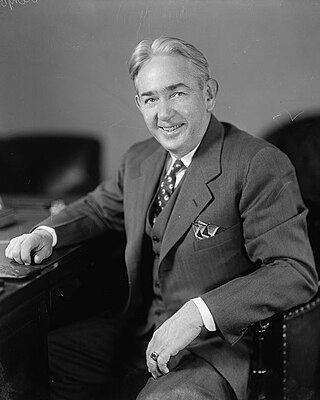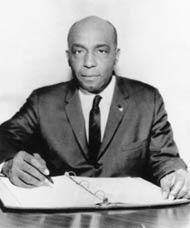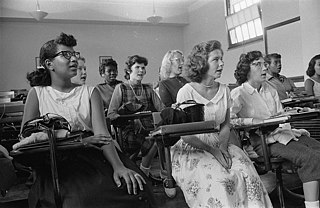Related Research Articles
Brown v. Board of Education of Topeka, 347 U.S. 483 (1954), was a landmark decision of the U.S. Supreme Court ruling that U.S. state laws establishing racial segregation in public schools are unconstitutional, even if the segregated schools are otherwise equal in quality. The decision partially overruled the Court's 1896 decision Plessy v. Ferguson, which had held that racial segregation laws did not violate the U.S. Constitution as long as the facilities for each race were equal in quality, a doctrine that had come to be known as "separate but equal". The Court's unanimous decision in Brown, and its related cases, paved the way for integration and was a major victory of the civil rights movement, and a model for many future impact litigation cases.

Desegregation busing was a failed attempt to diversify the racial make-up of schools in the United States by sending students to school districts other than their own. While the 1954 U.S. Supreme Court landmark decision in Brown v. Board of Education declared racial segregation in public schools unconstitutional, many American schools continued to remain largely racially homogeneous. In an effort to address the ongoing de facto segregation in schools, the 1971 Supreme Court decision, Swann v. Charlotte-Mecklenburg Board of Education, ruled that the federal courts could use busing as a further integration tool to achieve racial balance.

James Lindsay Almond Jr. was an American lawyer, state and federal judge and Democratic party politician. His political offices included as a member of the U.S. House of Representatives from Virginia's 6th congressional district (1946–1948), 26th Attorney General of Virginia (1948–1957) and the 58th Governor of Virginia (1958–1962). As a member of the Byrd Organization, Almond initially supported massive resistance to the integration of public schools following the United States Supreme Court decisions in Brown v. Board of Education, but when Virginia and federal courts ruled segregation unconstitutional, Almond worked with the legislature to end massive resistance.
Massive resistance was a strategy declared by U.S. senator Harry F. Byrd Sr. of Virginia and his son Harry Jr.'s brother-in-law, James M. Thomson, who represented Alexandria in the Virginia General Assembly, to get the state's white politicians to pass laws and policies to prevent public school desegregation, particularly after Brown v. Board of Education.

Oliver White Hill Sr. was an American civil rights attorney from Richmond, Virginia. His work against racial discrimination helped end the doctrine of "separate but equal." He also helped win landmark legal decisions involving equality in pay for black teachers, access to school buses, voting rights, jury selection, and employment protection. He retired in 1998 after practicing law for almost 60 years. Among his numerous awards was the Presidential Medal of Freedom, which U.S. President Bill Clinton awarded him in 1999.

Segregation academies are private schools in the Southern United States that were founded in the mid-20th century by white parents to avoid having their children attend desegregated public schools. They were founded between 1954, when the U.S. Supreme Court ruled that segregated public schools were unconstitutional, and 1976, when the court ruled similarly about private schools.

The Robert Russa Moton Museum is a historic site and museum in Farmville, Prince Edward County, Virginia. It is located in the former Robert Russa Moton High School, considered "the student birthplace of America's Civil Rights Movement" for its initial student strike and ultimate role in the 1954 Brown v. Board of Education case desegregating public schools. It was designated a National Historic Landmark in 1998, and is now a museum dedicated to that history. In 2022 it was designated an affiliated area of Brown v. Board of Education National Historical Park. The museum were named for African-American educator Robert Russa Moton.
Green v. County School Board of New Kent County, 391 U.S. 430 (1968), was an important United States Supreme Court case involving school desegregation. Specifically, the Court dealt with the freedom of choice plans created to avoid compliance with the Supreme Court's mandate in Brown II in 1955. The Court held unanimously that New Kent County's freedom of choice plan did not adequately comply with the school board's responsibility to determine a system of admission to public schools on a non-racial basis. The Supreme Court mandated that the school board must formulate new plans and steps towards realistically converting to a desegregated system. Green v. County School Board of New Kent County was a follow-up of Brown v. Board of Education.
Desegregation of the Baltimore City Public Schools took place in 1956 after the United States Supreme Court ruled, in the case of Brown v. Board of Education, that segregation in schools went against constitutional law. Desegregation of U.S. schools was part of the civil rights movement. The events that followed desegregation in Baltimore, were important to the civil rights movement across America. Recent scholarship has identified Baltimore's desegregation as an important precursor to the Greensboro sit-ins.

The Little Rock Nine were a group of nine African American students enrolled in Little Rock Central High School in 1957. Their enrollment was followed by the Little Rock Crisis, in which the students were initially prevented from entering the racially segregated school by Orval Faubus, the Governor of Arkansas. They then attended after the intervention of President Dwight D. Eisenhower.

Samuel Wilbert Tucker was an American lawyer and a cooperating attorney with the National Association for the Advancement of Colored People (NAACP). His civil rights career began as he organized a 1939 sit-in at the then-segregated Alexandria, Virginia public library. A partner in the Richmond, Virginia, firm of Hill, Tucker and Marsh, Tucker argued and won several civil rights cases before the Supreme Court of the United States, including Green v. County School Board of New Kent County which, according to The Encyclopedia of Civil Rights In America, "did more to advance school integration than any other Supreme Court decision since Brown."
The Stanley Plan was a package of 13 statutes adopted in September 1956 by the U.S. state of Virginia. The statutes were designed to ensure racial segregation would continue in that state's public schools despite the unanimous ruling of the U.S. Supreme Court in Brown v. Board of Education (1954) that school segregation was unconstitutional. The legislative program was named for Governor Thomas B. Stanley, a Democrat, who proposed the program and successfully pushed for its enactment. The Stanley plan was a critical element in the policy of "massive resistance" to the Brown ruling advocated by U.S. Senator Harry F. Byrd Sr. The plan also included measures designed to curb the Virginia state chapter of the National Association for the Advancement of Colored People (NAACP), which many Virginia segregationists believed was responsible for "stirring up" litigation to integrate the public schools.

School segregation in the United States was the segregation of students based on their ethnicity. While not prohibited from having schools, various minorities were barred from most schools, schools for whites. Segregation was enforced by formal legal systems in U.S. states primarily in the Southern United States, although elsewhere segregation could be informal or customary. Segregation laws were dismantled in 1954 by the U.S. Supreme Court because of the successes being attained during the Civil Rights Movement. Segregation continued longstanding exclusionary policies in much of the Southern United States after the Civil War. Jim Crow laws codified segregation. These laws were influenced by the history of slavery and discrimination in the US. Secondary schools for African Americans in the South were called training schools instead of high schools in order to appease racist whites and focused on vocational education. School integration in the United States took place at different times in different areas and often met resistance. After the ruling of Brown v. Board of Education, which banned segregated school laws, school segregation took de facto form. School segregation declined rapidly during the late 1960s and early 1970s as the government became strict on schools' plans to combat segregation more effectively as a result of Green v. County School Board of New Kent County. Voluntary segregation by income appears to have increased since 1990. Racial segregation has either increased or stayed constant since 1990, depending on which definition of segregation is used. In general, definitions based on the amount of interaction between black and white students show increased racial segregation, while definitions based on the proportion of black and white students in different schools show racial segregation remaining approximately constant.

The New Orleans school desegregation crisis was a period of intense public resistance in New Orleans that followed the 1954 U.S. Supreme Court ruling in Brown v. Board of Education that racial segregation of public schools was unconstitutional. The conflict peaked when U.S. Circuit Judge J. Skelly Wright ordered desegregation in New Orleans to begin on November 14, 1960.

In the United States, school integration is the process of ending race-based segregation within American public and private schools. Racial segregation in schools existed throughout most of American history and remains an issue in contemporary education. During the Civil Rights Movement school integration became a priority, but since then de facto segregation has again become prevalent.
This is a timeline of the civil rights movement in the United States, a nonviolent mid-20th century freedom movement to gain legal equality and the enforcement of constitutional rights for people of color. The goals of the movement included securing equal protection under the law, ending legally institutionalized racial discrimination, and gaining equal access to public facilities, education reform, fair housing, and the ability to vote.
William Lester Banks was an American leader during the Civil Rights Movement. He served as executive director of the Virginia section of the National Association for the Advancement of Colored People in his native Virginia from 1943-1976.
George T. Raymond was an American civil rights leader from Pennsylvania who served as president of the Chester, Pennsylvania, branch of the National Association for the Advancement of Colored People (NAACP) from 1942 to 1977. He was integral in the desegregation of businesses, public housing and schools in Chester and co-led the Chester school protests in 1964 which made Chester a key battleground in the civil rights movement.
The Chester school protests were a series of demonstrations that occurred from November 1963 through April 1964 in Chester, Pennsylvania. The demonstrations aimed to end the de facto segregation of Chester public schools that persisted after the 1954 Supreme Court case Brown v. The Board of Education of Topeka. The racial unrest and civil rights protests were led by Stanley Branche of the Committee for Freedom Now (CFFN) and George Raymond of the National Association for the Advancement of Colored Persons (NAACP).
The New Year's Day March in Greenville, South Carolina was a 1,000-man march that protested the segregated facilities at the Greenville Municipal Airport, now renamed the Greenville Downtown Airport. The march occurred after Richard Henry and Jackie Robinson were prohibited from using a white-only waiting room at the airport. The march was the first large-scale movement of the civil rights movement in South Carolina and Greenville. The march brought state-wide attention to segregation, and the case Henry v. Greenville Airport Commission (1961) ultimately required the airport's integration of its facilities.
References
- 1 2 3 "The Norfolk 17". WHRO. Retrieved November 5, 2019.
- 1 2 3 "Desegregation Of Norfolk Public Schools And The Norfolk 17". Coastal Virginia Magazine. Retrieved November 5, 2019.
- 1 2 3 4 5 "Hidden History: The Norfolk 17". WAVY.com. February 26, 2019. Retrieved November 5, 2019.
- ↑ "The Norfolk 17". BlackPublicMedia.org. March 13, 2007. Retrieved November 4, 2019.
- ↑ Daugherity, Brian J. (August 3, 2016). Keep On Keeping On: The NAACP and the Implementation of Brown v. Board of Education in Virginia. University of Virginia Press. ISBN 978-0-8139-3890-5.
- ↑ Littlejohn, Jeffrey L.; Ford, Charles H. (August 20, 2012). Elusive Equality: Desegregation and Resegregation in Norfolk's Public Schools. University of Virginia Press. ISBN 978-0-8139-3289-7.
- ↑ Watson, Denise. "The Norfolk 17 face a hostile reception as schools reopen". pilotonline.com. Retrieved December 12, 2019.
- ↑ The HistoryMakers video oral history with Andrew Heidelberg., interviewed by Larry F. Crowe, OCLC 997169088 , retrieved November 27, 2019
- ↑ PBS, Bringing It Together: The Norfolk 17 , retrieved November 27, 2019